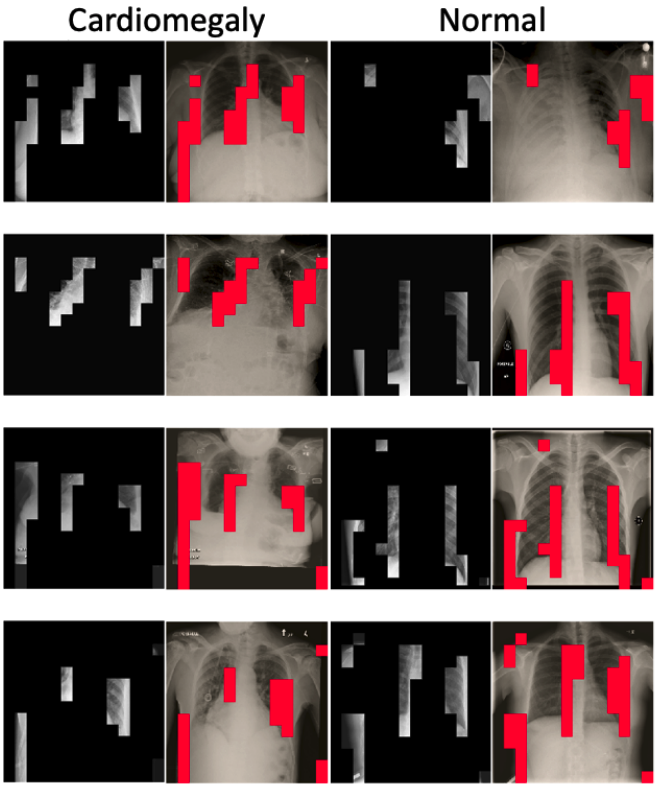publications
2021
 Have We Learned to Explain?: How Interpretability Methods Can Learn to Encode Predictions in their InterpretationsJethani, Neil, Sudarshan, Mukund, Aphinyanaphongs, Yindalon, and Ranganath, Rajesh2021
Have We Learned to Explain?: How Interpretability Methods Can Learn to Encode Predictions in their InterpretationsJethani, Neil, Sudarshan, Mukund, Aphinyanaphongs, Yindalon, and Ranganath, Rajesh2021While the need for interpretable machine learning has been established, many common approaches are slow, lack fidelity, or hard to evaluate. Amortized explanation methods reduce the cost of providing interpretations by learning a global selector model that returns feature importances for a single instance of data. The selector model is trained to optimize the fidelity of the interpretations, as evaluated by a predictor model for the target. Popular methods learn the selector and predictor model in concert, which we show allows predictions to be encoded within interpretations. We introduce EVAL-X as a method to quantitatively evaluate interpretations and REAL-X as an amortized explanation method, which learn a predictor model that approximates the true data generating distribution given any subset of the input. We show EVAL-X can detect when predictions are encoded in interpretations and show the advantages of REAL-X through quantitative and radiologist evaluation.
- FastSHAP: Real-Time Shapley Value EstimationJethani, Neil, Sudarshan, Mukund, Covert, Ian, Lee, Su-In, and Ranganath, Rajesh2021
Shapley values are widely used to explain black-box models, but they are costly to calculate because they require many model evaluations. We introduce FastSHAP, a method for estimating Shapley values in a single forward pass using a learned explainer model. FastSHAP amortizes the cost of explaining many inputs via a learning approach inspired by the Shapley value’s weighted least squares characterization, and it can be trained using standard stochastic gradient optimization. We compare FastSHAP to existing estimation approaches, revealing that it generates high-quality explanations with orders of magnitude speedup.
2020
- Myocardial Injury in Adults Hospitalized With COVID-19Smilowitz, Nathaniel R, Jethani, Neil, Chen, Ji, Aphinyanaphongs, Yindalon, Zhang, Ruina, Dogra, Siddhant, Alviar, Carlos L, Keller, Norma, Razzouk, Louai, Quinones-Camacho, Adriana, and others,Circulation 2020
- Estimating real-world performance of a predictive model: a case-study in predicting mortalityMajor, Vincent J, Jethani, Neil, and Aphinyanaphongs, YindalonJAMIA Open 2020
One primary consideration when developing predictive models is downstream effects on future model performance. We conduct experiments to quantify the effects of experimental design choices, namely cohort selection and internal validation methods, on (estimated) real-world model performance.Four years of hospitalizations are used to develop a 1-year mortality prediction model (composite of death or initiation of hospice care). Two common methods to select appropriate patient visits from their encounter history (backwards-from-outcome and forwards-from-admission) are combined with 2 testing cohorts (random and temporal validation). Two models are trained under otherwise identical conditions, and their performances compared. Operating thresholds are selected in each test set and applied to a “real-world” cohort of labeled admissions from another, unused year.Backwards-from-outcome cohort selection retains 25\% of candidate admissions (n = 23 579), whereas forwards-from-admission selection includes many more (n = 92 148). Both selection methods produce similar performances when applied to a random test set. However, when applied to the temporally defined “real-world” set, forwards-from-admission yields higher areas under the ROC and precision recall curves (88.3\% and 56.5\% vs. 83.2\% and 41.6\%).A backwards-from-outcome experiment manipulates raw training data, simplifying the experiment. This manipulated data no longer resembles real-world data, resulting in optimistic estimates of test set performance, especially at high precision. In contrast, a forwards-from-admission experiment with a temporally separated test set consistently and conservatively estimates real-world performance.Experimental design choices impose bias upon selected cohorts. A forwards-from-admission experiment, validated temporally, can conservatively estimate real-world performance.The routine care of patients stands to benefit greatly from assistive technologies, including data-driven risk assessment. Already, many different machine learning and artificial intelligence applications are being developed from complex electronic health record data. To overcome challenges that arise from such data, researchers often start with simple experimental approaches to test their work. One key component is how patients (and their healthcare visits) are selected for the study from the pool of all patients seen. Another is how the group of patients used to create the risk estimator differs from the group used to evaluate how well it works. These choices complicate how the experimental setting compares to the real-world application to patients. For example, different selection approaches that depend on each patient’s future outcome can simplify the experiment but are impractical upon implementation as these data are unavailable. We show that this kind of “backwards” experiment optimistically estimates how well the model performs. Instead, our results advocate for experiments that select patients in a “forwards” manner and “temporal” validation that approximates training on past data and implementing on future data. More robust results help gauge the clinical utility of recent works and aid decision-making before implementation into practice.